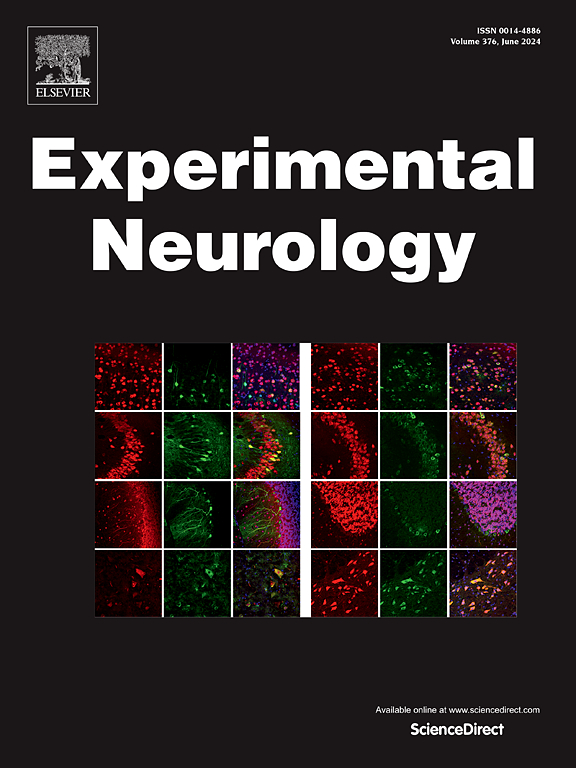缺血性中风后,小胶质细胞的增殖部分受反应性星形胶质细胞 ETBR 信号的调节。
IF 4.6
2区 医学
Q1 NEUROSCIENCES
引用次数: 0
摘要
反应性星形胶质细胞和小胶质细胞之间的相互交流为中枢神经系统损伤后的神经炎症、神经保护和疤痕形成等关键过程提供了局部、协调的控制,但对其了解甚少。血管活性肽激素内皮素(ET)在缺血性卒中和其他形式的脑损伤后早期由内皮细胞、小胶质细胞和星形胶质细胞释放和/或分泌。为了更好地了解脑卒中后神经胶质细胞的通讯,我们试图鉴定星形胶质内皮素受体B (ETBR)信号下游产生和分泌的旁分泌效应物。通过基因功能缺失筛选,我们发现血管生成素-2 (Ang-2)是星形胶质细胞对ET产生反应的一个因子。在用IRL1620(一种特异性ETBR激动剂)刺激的初级成人星形胶质细胞的实验中,我们发现ERK1/2和NFkB介导ET对Ang-2产生的影响。为了测定体内星形胶质细胞Ang-2水平,在脑卒中后3 天,通过磁激活细胞分选分离表达高亲和力谷氨酸转运体(GLAST, EAAT1)的反应性星形胶质细胞。与从对侧半球或假手术(对照)小鼠皮质分离的星形胶质细胞相比,从同侧半球获得的星形胶质细胞表达了更多的Ang-2。值得注意的是,从CX3CR1-eGFP小鼠中分选的小胶质细胞分析显示,同侧与对侧组织中获得的细胞中,Ang-2受体Tie-2的细胞表面表达增加。在星形胶质细胞条件培养基中加入重组Ang-2显著增加在缺氧条件下(1 %氧气48 h)培养的SIM-A9小鼠小胶质细胞的数量。在转基因GFAP-CreER™-EDNRB-fl/fl脑卒中小鼠中,有条件敲除星形胶质ETBR显著减少梗死周围小胶质表型(Ki67+/CD11b+)的增殖细胞数量。我们的研究结果表明,Ang-2以及其他可能在星形胶质ETBR信号下游发挥作用的旁分泌效应物是卒中后小胶质细胞动力学的重要介质。本文章由计算机程序翻译,如有差异,请以英文原文为准。
Microglial cell proliferation is regulated, in part, by reactive astrocyte ETBR signaling after ischemic stroke
Reciprocal communication between reactive astrocytes and microglial cells provides local, coordinated control over critical processes such as neuroinflammation, neuroprotection, and scar formation after CNS injury, but is poorly understood. The vasoactive peptide hormone endothelin (ET) is released and/or secreted by endothelial cells, microglial cells and astrocytes early after ischemic stroke and other forms of brain injury. To better understand glial cell communication after stroke, we sought to identify paracrine effectors produced and secreted downstream of astroglial endothelin receptor B (ETBR) signaling. Using a genetic loss-of-function screen, we identified angiopoietin-2 (Ang-2) as a factor produced by reactive astrocytes in response to ET. In experiments with primary adult astrocytes stimulated by IRL1620, a specific ETBR agonist, we found that ERK1/2 and NFkB mediated the effects of ET on Ang-2 production. To determine astroglial Ang-2 levels in vivo, reactive astrocytes expressing the high affinity glutamate transporter (GLAST, EAAT1) were isolated by magnetic-activated cell sorting 3 days after stroke. Astrocytes obtained from the ipsilateral hemisphere expressed significantly more Ang-2 compared with astrocytes isolated from the contralateral hemisphere, or from cortices of sham-operated (control) mice. Notably, analysis of microglia sorted from CX3CR1-eGFP mice demonstrated increased cell surface expression of Tie-2, the Ang-2 receptor, on cells obtained from ipsilateral versus contralateral tissue. Addition of recombinant Ang-2 to astrocyte-conditioned medium significantly increased the number of SIM-A9 murine microglial cells cultured under hypoxic conditions (1 % oxygen for 48 h). In transgenic GFAP-CreER™-EDNRB-fl/fl mice with stroke, conditional knockout of astroglial ETBR significantly decreased the number of proliferating cells in the peri-infarct area with a microglial phenotype (Ki67+/CD11b+). Our results indicate that Ang-2, and possibly other paracrine effectors functioning downstream of astroglial ETBR signaling, are important mediators of microglial cell dynamics after stroke.
求助全文
通过发布文献求助,成功后即可免费获取论文全文。
去求助
来源期刊

Experimental Neurology
医学-神经科学
CiteScore
10.10
自引率
3.80%
发文量
258
审稿时长
42 days
期刊介绍:
Experimental Neurology, a Journal of Neuroscience Research, publishes original research in neuroscience with a particular emphasis on novel findings in neural development, regeneration, plasticity and transplantation. The journal has focused on research concerning basic mechanisms underlying neurological disorders.
 求助内容:
求助内容: 应助结果提醒方式:
应助结果提醒方式:


